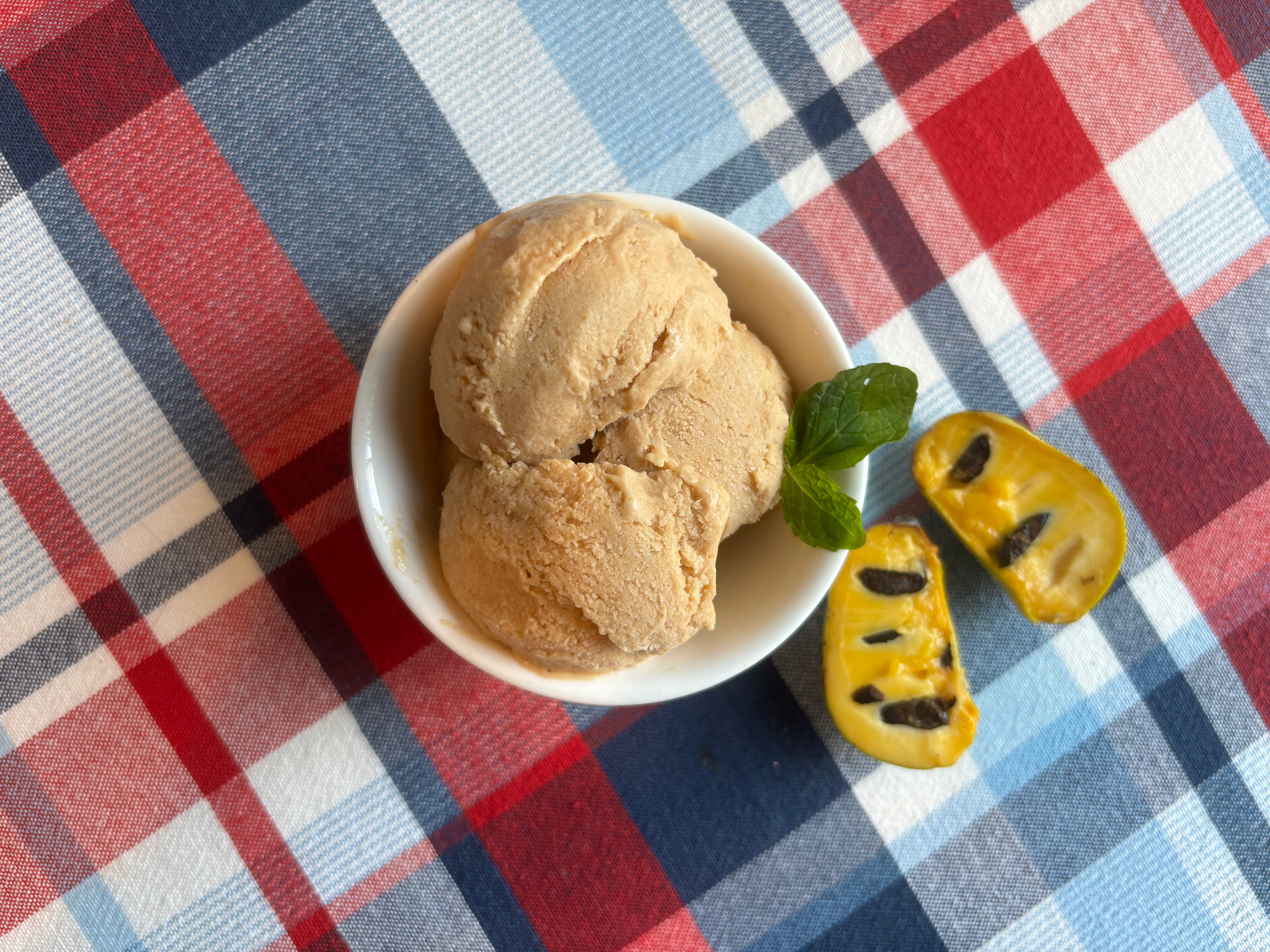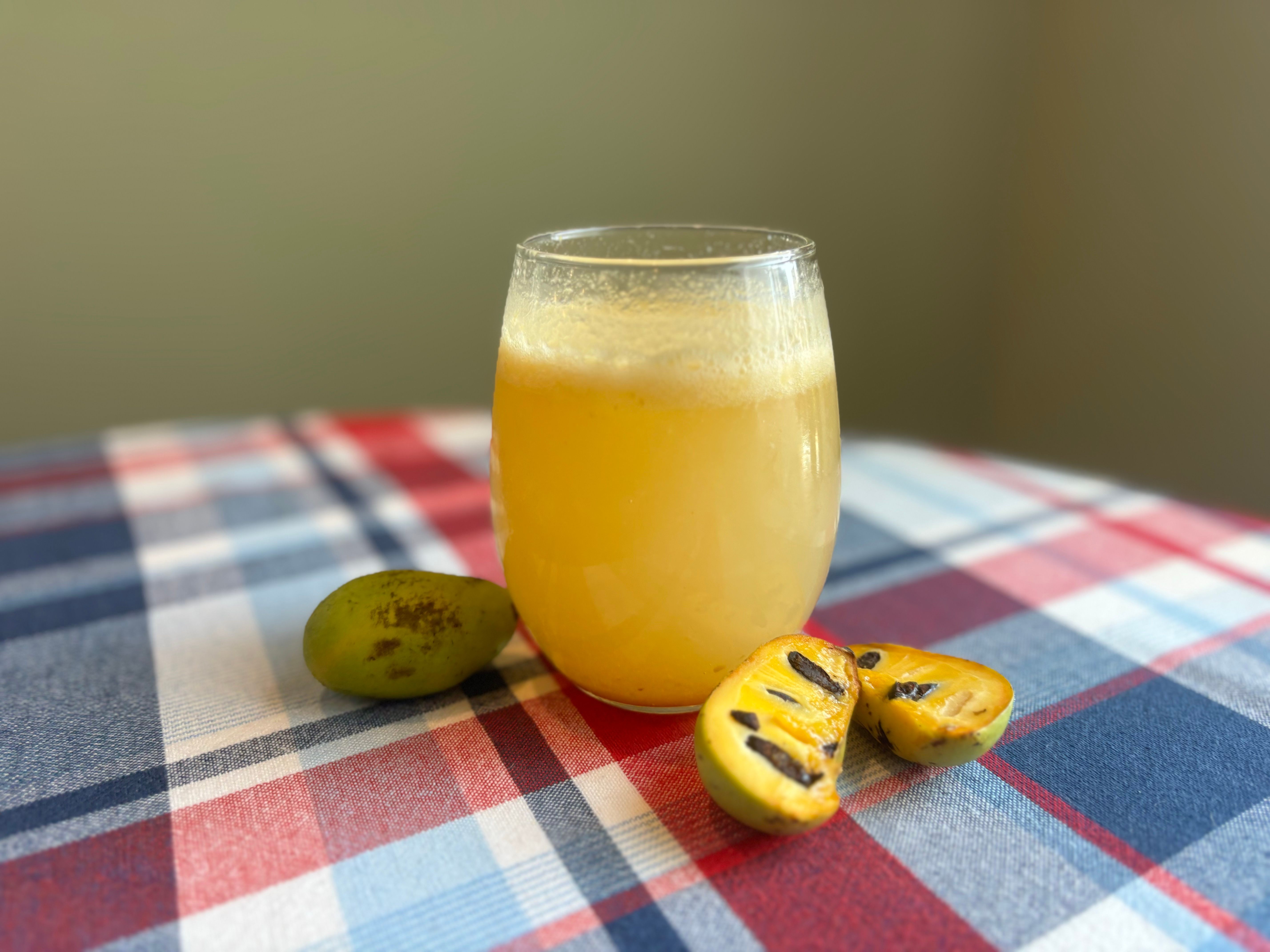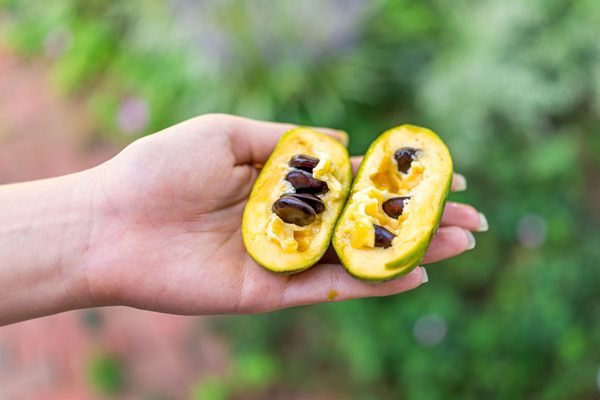This article is adapted from the September 21, 2024, edition of Gastro Obscura’s Favorite Things newsletter. You can sign up here.
Last weekend, I found myself walking along a shaded trail in Lancaster, Pennsylvania. A breeze blew from the Susquehanna River through the teardrop-shaped leaves that dangled overhead. As the wind shook the branches, I heard a dull thump. A pawpaw had fallen.
I ran over to the source of the sound and found a pastel-green orb. Its skin had split slightly from impact, revealing bright-orange pulp inside. “I don’t think this one will keep for taking home,” I told my partner. This might’ve been true, but I was really just giving myself permission to peel the skin back and take a bite.
As I sucked the juice from around the seeds—taking in a tropical flavor at a crossroads between banana, mango, and durian—and let the pulp’s custard-like texture settle on my tongue, I couldn’t believe this fruit was native to the United States. It reminded me of its cousins, soursop and cherimoya, fruits that grow in the tropical regions of Central and South America.
The pawpaw is North America’s largest native edible fruit. Archaeological evidence shows that megafauna like giant sloths enjoyed them 56 million years ago. Later, the Iroquois, who called it hadi’ot, used it as an ingredient in sauces and corn cakes. And African Americans fleeing slavery relied on its sweet flesh to fuel their journeys through Southern forests.
Today, wild pawpaws still grow in 26 states, from northern Florida to Pennsylvania and across the Midwest into Nebraska. But even though they appear in abundance each fall, few people are aware of the delicious treasures hiding nearby. I, for one, had no idea that one of the country’s largest pawpaw groves was just two hours from me.

I learned of Lancaster’s grove while reading Andrew Moore’s Pawpaw: In Search of America’s Forgotten Fruit, a deep exploration of the history of the pawpaw, why it faded into obscurity, and the communities working to preserve and promote both wild and cultivated varieties.
“Part of the wonderment in the book, for me, was just my amazement at this specimen of fruit,” Moore tells me later over the phone. He’s excited to hear about my first foraging experience. As he writes in the book, “I see the familiar look on people’s faces as they come out of the woods or walk away from a sampling table, that of puzzlement and wonder, wheels turning, grasping at the mystery and the possibilities.”
Back in Lancaster’s pawpaw grove, I was definitely pondering the mystery and possibilities of what I’d sampled and collected. Within a small area, the fruit grew in an incredible array of sizes and flavors. One carried a custard-like creaminess; another, a floral note of rose water; the next, a caramel richness. Some were shaped like avocados, others like unshelled peanuts. Moore tells me wild pawpaws can vary considerably depending on species, environment, and degree of ripeness.
There are few pleasures as simple as plucking fruit straight from its source, drinking in its juice, and spitting out its seeds beneath sun-dappled leaves. But foraging, appreciating, and preparing recipes with pawpaws isn’t always straightforward. To best enjoy this enigmatic fruit, I asked Moore for guidance on collecting, storing, and cooking with the pawpaw.
Foraging

Pawpaw trees are a great plant for novice foragers because their large teardrop leaves are easy to identify. If Moore’s four-year-old son can do it, you can too. Usually pawpaw trees form in thickets, so when you find those leaves, you’ll likely be among many plants. Scour the ground for freshly fallen fruit. And if there are ripe fruits dangling on the branches, a light shake of the thin trunk can make it rain pawpaws. (Just watch your head.)
When it comes to gauging ripeness, Moore goes by feel and fragrance. “You get them right when they have some give when you squeeze them—like when you’re squeezing a peach,” he says. “You will know when they’re fully ripe because they will be so fragrant.”
Moore also cautions against overharvesting. When I shamefully admit I probably went a bit overboard with my pawpaw haul, he reassures me this is normal for first-timers. “I was definitely guilty of this when I first learned about the fruit,” he says. “Once you’re there, you’re caught up in it because it’s this amazing tropical-tasting, custardy fruit. Why would you not get as much as you can?” But it’s important to just take what you need and save some for other foragers—both human and nonhuman (raccoons and possums are also big fans).
Processing All That Pawpaw
The best way to enjoy a pawpaw is freshly fallen and out of hand. But if you choose to take some home, you’ll have to act fast. “It’s not going to have much of a shelf life,” Moore says. “But if you pick the fruit off the tree when it’s perfect, you can store it in your refrigerator. I’ve let it ripen at room temperature for a day and then stored it in a refrigerator for up to 10 days or more.”
For a longer-lasting solution, purée and freeze the pulp. There are machines that can aid in the process, but my partner and I decided to peel and deseed our pawpaws by hand. It’s important to remove all seeds from your pulp, as full or even partial seeds can cause gastrointestinal distress. “I have puréed a seed and thought, Oh, how bad could it be? And I have found out the hard way that it is not fun,” Moore says.
Once you’ve got the skins and seeds removed, purée the pulp with a food processor. The results can be thrown into the freezer for later use or worked into recipes. To test a variety of pawpaw treats, I made ice cream, a shrub (an old-fashioned drink), and bread.
Frozen Delights

Moore says ice cream is, hands down, the best showcase for the pawpaw’s tropical flavor and aroma. He believes that smoothies or frozen treats, rather than cooked recipes, are better for capturing the pawpaw’s essence.
“I think cooking pawpaw diminishes its flavor and changes what’s unique and special about the fruit,” he says. “It’s something that’s best enjoyed fresh and full of that fresh aroma. You lose that when you cook or heat it too much.”
For people who can’t make their way to a pawpaw grove or strike out at the farmers’ market, pawpaw ice cream is a great way to sample its flavor. Check local creameries to see if they’re offering pawpaw flavors. In Philadelphia, where I live, Franklin Fountain serves a seasonal pawpaw ice cream.
Moore is such a fan of pawpaw ice cream that it’s the only recipe he includes in his book. He makes several batches each year.
Andrew Moore’s Pawpaw Ice Cream
2 cups pawpaw pulp
1 cup sugar
2 cups cream
2 cups milk
1. Combine the pawpaw and sugar.
2. Stir in the cream and milk.
3. Pour the mixture into an ice-cream maker and freeze according to the manufacturer’s instructions.
That sounds delicious, but I’m lactose-intolerant. So I made the below recipe, adapted from the Minimalist Baker’s vanilla coconut ice cream. The result was fruity and lightly floral. It had a tropical sweet-and-slightly-sour taste, but was also heavy on the creaminess—something that can be a struggle when you’re replacing cream in a dairy-free recipe.
Pawpaw-Coconut Ice Cream
2 cups pawpaw pulp
1 cup full-fat coconut milk
1 cup coconut cream
1/2 cup to ¾ cup cane sugar
1 pinch sea salt
2 teaspoons pure vanilla extract
1. Add the pawpaw pulp, coconut milk and cream, cane sugar, sea salt, and vanilla extract to a high-speed blender, and blend on high for a few minutes until creamy and smooth. Test and add sugar if it needs more sweetness.
2. If you’re like me and don’t have an ice-cream maker, add the mixture to two loaf pans and place them, covered, in the freezer. For the next six hours, stir to incorporate some air every hour or so, then allow to freeze completely until firm.
Cooking Caveats

When dealing with a fascinating fruit, it’s tempting to experiment with new recipes. Moore recommends getting acquainted with the pawpaw’s dangers before getting too adventurous. When novices don’t learn about the toxicity of the skin and seeds, for instance, they might incorporate them into a recipe.
Then there’s the uncertainty of cooking with pawpaw. The internet abounds with cautionary tales of people who became sick after eating cooked or dehydrated pawpaw. The latter has a particularly bad reputation for making people ill, unless the fruit is prepared a certain way.
When it comes to cooking pawpaws, reactions vary. Some people get nauseous from pawpaw cookies or cakes, while others devour these treats with no issues. Yet Kentucky State University, which has the only full-time pawpaw research program in the world, has a robust archive of pawpaw recipes, including plenty of baked goods.
Because I trust KSU and because I remained committed to testing a spectrum of pawpaw delicacies for you, dear readers, I made their pawpaw bread recipe. I was totally fine after having a slice with my morning coffee. It tasted like a slightly bitter banana bread—unsurprising since the pawpaw is also known as the “poor man’s banana.”
Pawpaw Potables

In 1896, Kentucky’s Courier-Journal gave this ringing endorsement for pawpaw beer: “A pint of it will take the paint off a brick house and make a man forget he has a mother-in-law.” Today’s pawpaw beers might not be as potent, but plenty of breweries in America’s “Pawpaw Belt” still incorporate the fruit into seasonal IPAs, sours, wheat ales, and more. It’s worth checking if a brewery near you is producing a batch of pawpaw beer. But if not, you can always make your own pawpaw-flavored beverage.
I don’t have the patience to brew beer, so I decided to make a pawpaw shrub. I used a recipe from Modern Farmer, which author Danny Childs recommends using as the base for a Pawpaw Pisco Sour.
I poured two tablespoons of the shrub in a wine glass and topped up with ginger-flavored seltzer. The drink was tart and sweet, although I’ll admit the flavor of the pawpaw didn’t come through as strong as it did in other recipes I tested. It may have been overpowered by the sourness of the vinegar. But I didn’t follow the recipe’s recommendation to let it sit for one week before sampling (deadlines called!). I’ll give it some more time and see if the flavors blend better.
Until Next Season…
After his years of visiting festivals, exploring forests and cultivated orchards, and eating many, many varieties, I ask Moore if he’s ever grown sick of pawpaws. He says he hasn’t and that it’s easy to maintain a sense of wonder around a fruit that ripens only in September and October.
For Moore, knowing the possibilities of the pawpaw makes the anticipation of each season even more exciting. “When it gets to late summer, and I have my cues in nature—in Pittsburgh, the goldenrod starts coming in—I still get excited thinking about pawpaw season coming up. I can smell it and taste it. I look forward to it every year.”
Gastro Obscura covers the world’s most wondrous food and drink.
Sign up for our email, delivered twice a week.

